Introduction:
Satellite imaging technology has revolutionized the way we perceive and interact with our world. From monitoring green changes to aiding in disaster management, the applications of this technology are vast and diverse. In this item, we will explore the intricacies of satellite imaging, its growth, and its impact on various industries.
1. Satellite imaging technology definition
- Using man-made satellites, satellite imaging technology takes pictures of the face of the world. These photos add to subjects like environmental science, farming, and urban planning by offering insightful information on many facets of our globe.
1. Development and Significance
Satellite imagery has changed considerably over time. Early satellites produced low-resolution photos, but technological developments have produced remarkably clear high-decree photography. The capacity of satellite imagery to offer a thorough perspective of the Earth’s face from orbit makes it significant.
1. The Operation of Satellite Imaging
2. Sensors and Satellite Orbits
With distinct functions, satellites are arranged in various orbits about the Earth intentionally. They can provide detailed images because they have sensors that can detect electromagnetic radiation. The chosen applications determine which orbit and which sensors to use.
1. Image Capture Method
Signals are transmitted from the satellite to the surface of the Earth to make films. When these signals return to the satellite, they include important data that is processed to produce finely detailed images. It takes only a few seconds to complete, allowing for real-time monitoring.
III. Uses in Different Industries
1. Farming
The use of satellite imagery is essential to contemporary farming. Farmers use these photos to track crop health, pinpoint regions that need irrigation, and manage resource usage. Precision farming is made likely by technology, which results in higher yields and sustainable farming methods.
Google Maps Satellite View Live A Window to the World
1. Monitoring the Environment
Satellite imagery is used by green scientists to monitor natural disasters, deforestation, and changes in ecosystems. Large-scale space monitoring offers a full perspective on green changes, at the bottom of conservation initiatives and policymaking.
1. City Planning
To develop cities and build roads, urban planners use satellite imagery. Planning for sustainable urban growth, tracking construction operations, and evaluating land use patterns are all made easier by technology. It aids in the development of store-efficient smart cities.
1. Progress in Satellite Imagery
2. Imaging with High Resolution
Recent developments have resulted in the making of satellites that can take extraordinarily detailed pictures. Applications demanding accuracy, like monitoring particular infrastructure projects or map urban areas, greatly benefit from high-resolution imagery.
- Technology Using Synthetic Aperture Radar (SAR)
Regardless of the weather or time of day, fake Aperture Radar provides detailed images that improve satellite imaging capability. SAR technology is above all useful for defense and disaster management applications.
1. How Disaster Management Is Affected
2. Systems of Early Warning
The development of early warning systems for natural disasters including hurricanes, earthquakes, and floods is aided by satellite imaging. Authorities can effectively deploy resources and evacuate impacted areas with timely information.
1. Post-Disaster Evaluation
Satellite photos help determine the level of damage and sort out recovery activities following a disaster. During emergencies, technology enables quick action.
1. Upcoming Developments in Satellite Imaging
2. Integration of Artificial Intelligence
A trend that shows promise is the combination of artificial intelligence and satellite imagery. Massive data sets can be analyzed by AI algorithms, allowing for the meaningful removal of insights and the ID of patterns that could be complex for human analysts to spot.
VII. Difficulties and Restrictions
1. The Weather and Cloud Cover
Cloud cover and bad weather can cause prying with satellite imaging, which is one of the issues it faces
1. Price and Availability
Even with advances in technology, the expense of launching and maintaining a satellite continues to be a barrier. Partnerships between international organizations, businesses, and governments are being used to improve accessibility.
VIII. Distinguishing Satellite Imaging from Usual Techniques
1. Analogous Study Using Helicopter Photography
Comparing satellite imaging to usual aerial photography reveals a wider angle. Satellites are more effective for many applications because they can cover more areas.
1. Benefits of Observations from the Ground
A global perspective is provided via satellite imaging as opposed to ground-based observations. It provides data that may be difficult to gather by ground-based means, making it especially useful for monitoring remote or inaccessible places.
1. The Public and Private Sectors’ Roles
2. Initiatives by the Government
Across the globe, governments acknowledge the weight of satellite imagery and allocate funds toward scientific research, environmental surveillance, and national security initiatives. Governments and private companies frequently work together to press on satellite technology.
1. Contributions from the Private Sector
It is higher in large part by private firms. They advance the sector by fostering innovation, the production of satellites, and the creation of expert applications.

